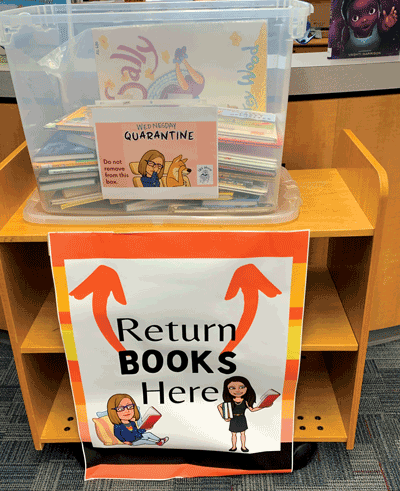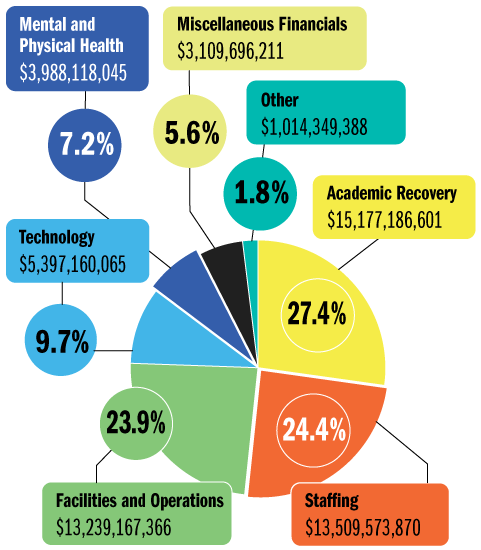Put ESSER Dollars to Work: School Libraries Can Benefit from American Rescue Plan Funds
School districts are devising plans to spend the third round of ESSER funds, $122 billion, signed into law in March 2021.
 |
TeamOktopus/Getty Images (modified) |
Back in March 2020, Congress set aside over $13 billion for schools to address their immediate needs in the wake of classroom shutdowns and remote learning. This was the first round of a distribution known as ESSER (Elementary and Secondary School Emergency Relief) funding. Districts were given wide discretion on how to spend the money, as long as it benefitted students and helped them stay on track.
Christy James, the library coordinator for Charleston County (SC) School District (CCSD), felt that her district’s 76 libraries should be a priority when schools opened their doors again later that year, so she received some ESSER funding for two simple, but significant, purchases: large plastic bins for every school library and mobile book carts.
In the early days of the pandemic, studies about how easily someone could catch COVID-19 from surfaces were confusing, and James wanted to make sure kids could check out books without passing on the virus to the next borrower. With the bins, librarians could essentially quarantine books students had checked out and returned. The carts allowed the librarian to visit each classroom, so students didn’t have to cycle in and out of different rooms to check out a book.
“The only purpose was really to make sure that if we had kids back in school, the library was still going to be part of their learning experience,” James said. “That was the most important immediate concern.”
In James’s district, the portion of funds used for the libraries was small, but it allowed them to continue doing their jobs in a safer way. James said ESSER funds used elsewhere in the district freed up some other annual funding to cover more than $307,000 in lost books.
At the end of 2020, Congress doled out the second round of ESSER funds, more than $54 billion. And now, districts are devising plans to spend the third and largest round, $122 billion, which was signed into law in March 2021 as part of the American Rescue Plan.
 |
Library coordinator Christy James used ESSER funds to buy mobile book carts and large plastic bins for all 76 school libraries in her district. |
Most districts have gotten millions from all three rounds: Congress provided the funds to states, which then distributed them to districts based on Title I formulas that accounted for the number of low-income students in the district.
Observers tracking how districts spend this money say that while school libraries aren’t a big spending category in general, librarians are finding ways to use the money to bolster their collections, invest in new curriculum, and hire staff.
With the latest—and largest—round of funding, librarians are looking further than immediate needs; they are making longer-term plans to help students recover from learning loss and become more well-rounded learners.
The Georgetown Edunomics Lab is tracking district spending on ESSER III. So far, many districts haven’t spent their money and may have a hard time doing so before the October 2024 deadline, says Jessica Swanson, senior fellow at the Edunomics Lab. Though districts have flexibility in spending, the act requires them to spend at least 20 percent of this round on efforts to address learning loss and a smaller portion on aftercare and summer school.
The biggest category of spending, Swanson says, is “other,” making it unclear exactly where the money is going.
“Districts were asked to categorize their spending, and so far it’s not been super conclusive if they are spending it on just one thing,” she says. “Obviously we are seeing hiring, we are seeing spending on instructional materials and on facilities, and things like improving HVAC systems.”
Part of the difficulty in tracking the spending is that all states are reporting it differently using their own systems. Some are more transparent, with easy-to-navigate websites, while others are murkier. Furthermore, many districts are still devising plans on how to spend the largest portion of funds.
The Center on Reinventing Public Education is tracking spending plans in 100 large and urban districts. So far 11 of those districts haven’t made their plans public yet, according to Bree Dusseault, the center’s principal. Among the priorities revealed in the plans, she says, are learning acceleration supports, additional staffing, investments in counselors and mental health resources, and facility upgrades and improvements.
School libraries don’t often come up as a category of spending, but other initiatives may intersect with libraries, Dusseault notes. Many states are pushing districts to invest in reading and literacy. Utah, for example, plans to allocate more money to districts with lower performances on state reading tests. These districts will receive extra training and professional development in the science of reading, and it’s easy to see how school libraries may be a part of this.
In other districts where libraries may not directly benefit from ESSER funds, librarians are still finding ways to benefit indirectly. James says ESSER funding for her district has freed up more Title IV funding, allocated annually by the federal government to improve student academic achievement, to purchase ebooks focused on social-emotional learning. Librarians are working with school counselors, she says, to help kids and their families work through the lasting trauma and stress of the pandemic.
“It became very evident during the pandemic that the library was going to continue to be the hub it needed to be,” James says. “The pandemic provided some unique opportunities to be able to reach out beyond the library and work with other departments, like our [English as a Second Language] department, like our school counselors, to really make sure that we’re right there helping take care of our kids and getting them what they need.”
Albuquerque (NM) Public Schools has received around $350 million in three rounds of ESSER funding. In the second round, librarians used the money to buy ebooks for the school library and classroom libraries, according to Heather Bassett, former district policy analyst and school librarian. (Bassett recently became K–12 district sales manager for Gale, part of Cengage Learning.)
With the third round, the district has so far focused spending on tutoring, professional development for teachers, and HVAC. One portion—about $16 million—is slated for expanding the district’s culturally responsive curriculum, a project resulting from a partnership between the district’s library director and the language and cultural equity director.
The partnership began about five years ago with a steady purchasing of books that reflect students’ cultures and backgrounds, from Frida Kahlo and Her Animalitos by Monica Brown for elementary students to The Hate U Give by Angie Thomas for eighth graders. When the pandemic hit, they used ESSER funds and other funding sources to buy ebooks for the titles they already had. Kids couldn’t come to school to check out books, but they all have devices, says Rachel Altobelli, district director of library services.
ESSER Spending Trends
While libraries could be included in almost any category, so far experts don’t see them explicitly “I have seen athletic fields, swimming pools, or school building upgrades, and as part of school building upgrades it certainly could include libraries,” says Bree Dusseault, the principal of the Center on Reinventing Public Education, which is also tracking spending plans. “But I’m not actually seeing libraries being called out as a strong initiative.” Many districts are still devising plans—and plans may change as they are implemented if, for example, they aren’t able to find enough staff to hire for tutoring initiatives, says Jessica Swanson, senior fellow at the Edunomics Lab. “You don’t have to stick with your original plan,” Swanson advises districts. “You can still change it up. We need to make sure there’s an evaluation involved because when there’s not, we stand to not benefit from this significant investment.” CHART: Here’s where funding allocation stood as of April, according to Future-Ed.
|
Altobelli says the ESSER funds alone weren’t necessarily a significant amount, but combined with other funding, some of which had been freed up because ESSER dollars were spent elsewhere, they allowed her and the director of the language and cultural equity department to expand work they’d begun several years before the pandemic. She recommends using these one-time funds to advance meaningful projects rather than trying to build new ones from scratch in the limited time frame.
“It gives you options and you can expand your scale,” Altobelli says. “All the extra funding in the world won’t make a difference if you do not have a plan and an idea that you genuinely believe will make a difference.”
Some districts have invested directly in school libraries. Swanson, of the Edunomics Lab, says the Oakland (CA) Unified School District has hired library technicians; other districts, however, are cutting positions rather than adding as budgets change amid enrollment slumps, particularly in larger urban districts. New York City public schools are looking into investments in library services, including purchasing more library materials in students’ home languages for multilingual learners.
One danger of hiring new staff with ESSER funds, Swanson warns, is that the funding is a one-time distribution. If schools plan to keep that staff member for more than a few years, they will have to find another way to pay for it once ESSER funds run out. Pittsfield (MA) Public Schools used a previous round of ESSER funding to hire a full-time librarian so both of the district’s high schools would have their own, according to the local news outlet iBerkshires. For next year’s budget, the district eliminated two other positions to make the librarian permanent, staving off the looming ESSER funding cliff.
Swanson and Dusseault recommend that districts still devising plans for ESSER III focus on investments that don’t need to be recurring to make an impact on students. Another key, adds Swanson, is to communicate this to school communities and set realistic expectations, particularly for investments like summer school or tutoring that require extra staff.
“Even if it is a one-time service, it’s still important for the community to understand that. If that goes away, that could still feel like a loss if you’re not clear that it was a one-time investment,” Swanson says.
As the CCSD plans how to spend ESSER III dollars, James has many hopes for further investment in libraries. For one, she’d like to update their print collections now that kids are back in school and make sure all schools have equal amounts of new books that address student needs now, including mental health. But no matter what happens, she’s grateful for funding received early in the pandemic, which started them off on the road to recovery.
“We didn’t miss a beat coming back with the kids,” James says, “whether we were providing curbside service, or whether we were providing classroom delivery from holds. Those materials allowed us to have a plan in place right away.”
Colleen Connolly is a Minneapolis-based freelance journalist who writes about education and other topics.
RELATED
The job outlook in 2030: Librarians will be in demand
The job outlook in 2030: Librarians will be in demand
ALREADY A SUBSCRIBER? LOG IN
We are currently offering this content for free. Sign up now to activate your personal profile, where you can save articles for future viewing

 Using data from the data services firm Burbio, the Georgetown think tank Future-Ed
Using data from the data services firm Burbio, the Georgetown think tank Future-Ed 



Add Comment :-
Be the first reader to comment.
Comment Policy:
Comment should not be empty !!!